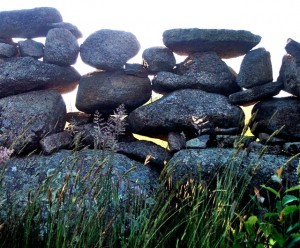On two recent occasions, I was interviewed by Joe Rankin for two articles on stone walls for Northeast Woodlands magazine. The first was about the creatures inhabiting stone walls. The second was a Q&A on curious facts about stone walls. In preparation for the second interview, I jotted down a few points for discussion, which I share below:
Stone walls are landforms. In fact, they are signature landforms, defining our region as do the lakes of Minnesota, the caverns of central Appalachia, the canyons of the Southwest, and the volcanoes of the Northwest. Indeed, we live in the Anthropocene epoch, in which human beings are the dominant agency on the planet. One of the things we do is move mass from one place to another at a greater average rate than did the glaciers during the ice age, a previous epoch. The stone walls are the most widespread an ubiquitous indicator of our power.
Stone walls reveal that we are part of nature. Prior to the age of fossil fuels, the mass moved by muscle power is so monumental, the geographic pattern so widespread, and the style so uniform that we must concede that New England’s stone walls emerged naturally as a consequence of the conversion of forest to farm. Above this “natural” expression of agroecology is the cultural gloss. Thus, walls are more analogous to the dam’s of beavers than to the fortress walls of castles. They are “artifacts” arising from an ecological imperative.
At the peak, there were about 250,000 miles of stone wall in New England, based on historic inventories by Robert Thorson (Stone by Stone) and on statistical predictions based on LiDAR mapping in southern New England by a team from the University of Connecticut [1].
The average height of a stone wall is indeed “thigh high,” as Thorson claimed based on the anecdotal evidence of thousands of walls. This average wall was confirmed by Johnson and Ouimet’s statistical analysis to be 0.76 ± 0.23 m high and 0.96 ± 0.50 m wide.
Prior to the Gilded Age (of outside money), most walls were built on farms one segment at a time by people from those farms and with resources coming from those farms. During and after the Gilded Age, many of the original walls were built (upgraded) as capital improvements by expert laborers (masons) paid for with money coming from urban and industrial wealth.
The oldest documented stone wall in New England was built in 1607 by English residents of a “Virginia” colony at Sagadahoc, Maine, now known as Popham Point, located at the mouth of the Kennebec River, Maine. A letter describing that site from the 1620s described “Rootes and Garden Hearbes and some old Walls” left behind after that one-year attempt at colonization failed [2].
Footnote 1. “Physical properties and spatial controls of stone walls in the northeastern USA: Implications for Anthropocene studies of 17th to early 20th century agriculture,” Katharine M.JohnsonWilliam B.Ouimet, Anthropocene 15: Sep 2016, 22-28). https://doi.org/10.1016/j.ancene.2016.07.001)
Footnote 2. This quote is from Thorson, Stone by Stone (New York: Walker & Co., p. 77), adapted from historian Howard Russell’s The Long Deep Furrow (Hanover, NH: University Press of New England, 1976, p. 9).
Photo: Lace wall in Chilmark, Martha’s Vineyard, MA.
